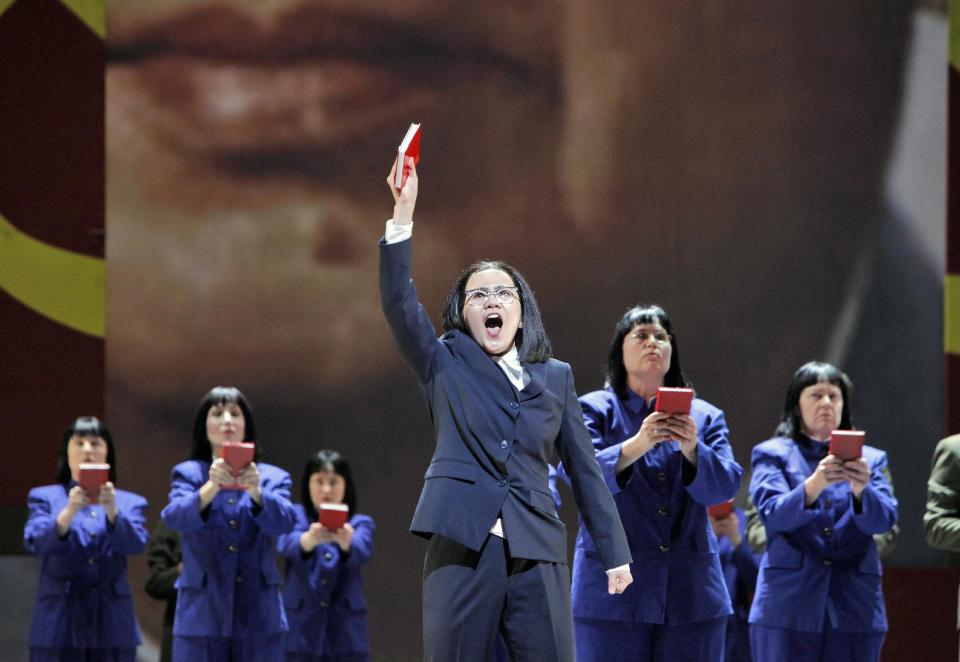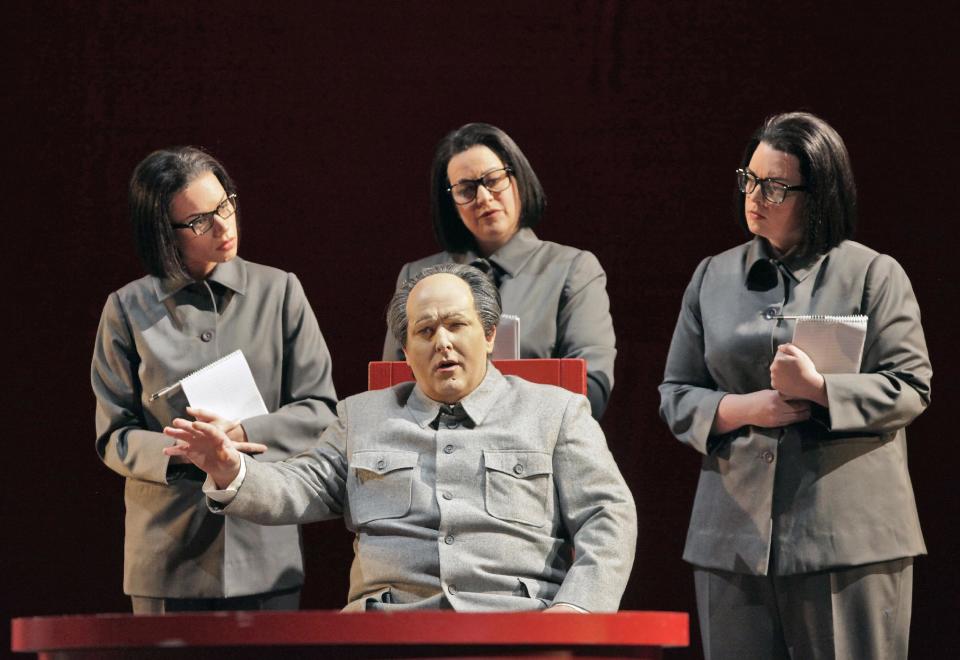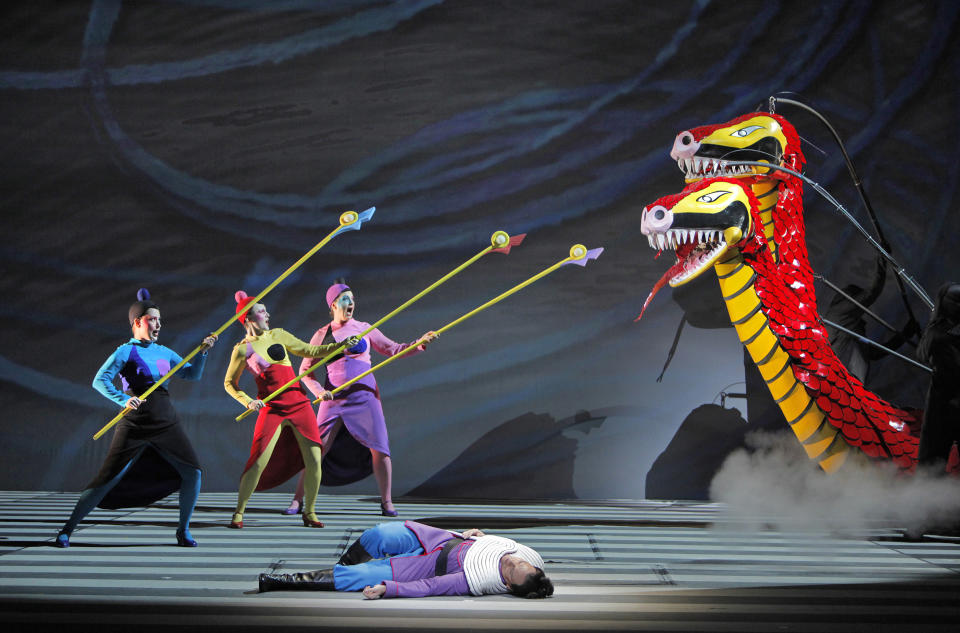'Nixon' headlines SF Opera's summer season
SAN FRANCISCO (AP) — Like a conquering hero returning home, Richard Nixon is drawing cheers from California audiences these days.
Not as the former president, but as the subject of an opera.
"Nixon in China," increasingly recognized as a modern masterpiece, is finally getting the recognition it deserves on the home ground of composer John Adams, in a sparkling production that highlights the San Francisco Opera's summer season.
Also on view through July 8 are a musically rousing rendition of Verdi's "Attila," and a visually captivating take on Mozart's "The Magic Flute."
Adams, a longtime Bay Area resident, collaborated on his first opera with librettist Alice Goodman under the guiding hand of director Peter Sellars. From a mixed reception at its 1987 premiere in Houston, it has gone on to triumphs around the world, including last year at the Metropolitan Opera.
Until now it had never been staged in San Francisco, where David Gockley, who brought that first production to Houston, now runs the company.
This "Nixon," seen at its second performance Thursday night, is an altogether joyous affair, deftly directed by Michael Cavanagh with terrific sets by Erhard Rom and an exceptional cast of singers who handle Adams' difficult vocal writing with ease.
The production, originally seen in Vancouver, creates a sense of fluidity that matches Adams' score and keeps the essentially plotless work from seeming static.
The opening scene, with a crowd of Chinese dignitaries awaiting the arrival of Air Force One for Nixon's historic 1972 visit, uses projections to show the jetliner materializing through clouds with the president seated alone at a window. The dream-like closing scene, in which the characters muse on the pasts and the future, keeps them moving in intricate patterns, with Madame Mao at one point being wheeled on a tray full of food with arms outstretched toward her husband.
Singing the role of Nixon for the first time, baritone Brian Mulligan attacked the vocal line with solid, resonant tone, reveling in the jerky rhythms of his "News" aria. Soprano Maria Kanyova was a lovely, sympathetic Pat Nixon; Simon O'Neill brought heldentenor strength to the role of Mao, and the tiny, young Korean coloratura soprano Hye Jung Lee drew a huge ovation for her furious rendition of Madame Mao's chilling aria.
Bass-baritone Patrick Carfizzi made the most of the buffoonish role assigned to Henry Kissinger, and baritone Chen-Ye Yuan provided quiet dignity as Chou En-lai, who gets the opera's last lines, wondering, "How much of what we did was good?"
Lawrence Renes conducted with an energy and sweep that made the score consistently fresh and exciting.
One night earlier, the company unveiled a charming new production of "The Magic Flute" by Japanese artist Jun Kaneko. It uses colorful animated drawings of geometrical forms and lines, swirls and curlicues that are digitally projected onto the curtain and stage backdrops to form an ever-shifting accompaniment to the action. These drawings are matched by the strikingly eccentric costumes, heavy on polka dots and triangular or oval shapes.
After a sluggish first act (partly the fault of conductor Rory Macdonald), things picked up considerably in Act 2. Soprano Heidi Stober blossomed into a radiant Pamina, while coloratura Albina Shagimuratova dazzled with her high notes in the Queen of the Night's vengeance aria (which Adams took as inspiration for Madame Mao's big scene.).
The men were less impressive. Bass Kristinn Sigmundsson's sound evaporated whenever he had to dip into his lowest register; baritone Nathan Gunn was an amiable but light-voiced Papageno, and tenor Alek Shrader, announced as suffering from a cold, sang cautiously as Tamino.
The opera was given in a new English translation by Gockley himself. It had a nicely colloquial feel but too often resorted to cheap jokes, as when Tamino, hearing Papageno mention the "Star-flaming queen," responds: "Sounds like something out of a drag show!"
The rewards of "Attila," which opened on Tuesday, were all on the musical side. The head-scratching production, a joint project with La Scala, begins evocatively, with bodies impaled on spikes next to the ruins of a Roman amphitheater. But director Gabriele Lavia tries to make the case for Verdi's early opera as a case study in oppression and rebellion through the ages by placing each act in a different historical period. This concept reaches absurdity in Act 3, set in the wreckage of a modern movie theater, which happens to be playing a film about Attila.
Still, "Attila" crackles with irresistible raw energy and passion — and music director Nicola Luisotti brought out these qualities in his conducting.
As the barbaric Hun (more sinned against than sinning in this piece), bass Ferruccio Furlanetto dominated the stage with his dark, rich voice and brooding charisma. Baritone Quinn Kelsey was his equal as the Italian warrior Ezio, his warm, resonant sound at times reminiscent of the great Leonard Warren.
As Odabella, soprano Lucrecia Garcia began promisingly, tearing through her opening aria "Santo di patria" with aplomb. Subsequently, however, her tone tended to sound thin on her high notes.
Tenor Diego Torre, as the knight Foresto, has a voice too small for the role and frequently showed signs of strain. One had to feel sorry for him when, during his third-act aria, he was forced to compete for our attention with a flickering image of Jack Palance rampaging through the 1954 Hollywood production "Sign of the Pagan."
It was no contest.





